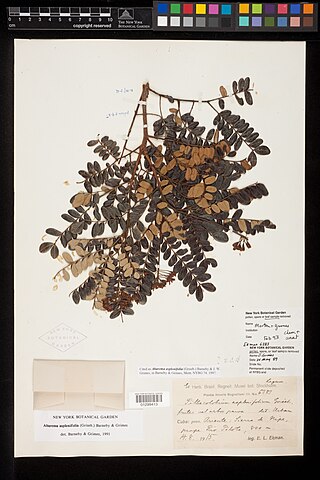
Abarema is a neotropical genus in the family Fabaceae. It is native to Brazil, Cuba, and Venezuela. Most of the species can be found in the Amazon Basin and the Guyana Highlands. They have a deep-green fernlike foliage, with bipinnately compound leaves.

Abarema abbottii, the Abbott abarema, is a species of plant in the family Fabaceae. It is found only in the Dominican Republic, and is confined to broad-leaved woodlands on limestone soils.

Abarema cochliocarpos is a species of tree in the legume family, Fabaceae. Its common name is barbatimão. It is endemic to Brazil, where it occurs in Alagoas, Bahia, Paraíba, Pernambuco, Rio de Janeiro, Rio Grande do Norte and São Paulo.
Abarema ganymedea is a species of plant in the family Fabaceae. It is known from only two locations: North Antioquia in Colombia, and Esmeraldas in Ecuador.
Abarema josephi is a species of plant in the family Fabaceae. It is known only from the type locality in Caquetá, Colombia.
Hydrochorea acreana is a tree species in the legume family (Fabaceae). It is native to portions of Central and South America, including Nicaragua, Costa Rica, Colombia, Venezuela, Peru, and northern Brazil. Fruiting trees apparently have never been found.

Abarema adenophora is a species of plant in the family Fabaceae. It is native to Northern South America, Costa Rica, and Nicaragua.
Abarema alexandri is a species of plant of the genus Abarema in the family Fabaceae. It is endemic to Jamaica, where it can be found in woodland or thicket on limestone soils.

Abarema aspleniifolia is a species of plant of the genus Abarema in the family Fabaceae.
Abarema campestris is a species of plant of the genus Abarema in the family Fabaceae.
Abarema curvicarpa is a species of plant of the genus Abarema in the family Fabaceae. It can be found in Brazil, French Guiana, Guyana and Suriname.

Abarema jupunba is a species of plant of the genus Abarema in the family Fabaceae.
Abarema langsdorfii is a species of plant of the genus Abarema in the family Fabaceae.
Abarema leucophylla is a species of plant of the genus Abarema in the family Fabaceae.
Abarema levelii is a species of plant of the genus Abarema in the family Fabaceae. It is native to Venezuela and north Brazil.
Abarema microcalyx is a species of plant of the genus Abarema in the family Fabaceae.

Abarema mataybifolia is a species of plant of the genus Abarema in the family Fabaceae.

Abarema oppositifolia is a species of plant of the genus Abarema in the family Fabaceae.
Abarema piresii is a species of plant of the genus Abarema in the family Fabaceae. The species can be found in the state of Pará in northern Brazil. It was first published by Rupert Charles Barneby and James Walter Grimes in Acta Amazonica 14(1/2): 96, fig. 1. 1984[1986].
Abarema alexandri var. troyana is a variety of the legume A. alexandri in the family Fabaceae. It is endemic to Jamaica, where it can be found in woodland or thicket on limestone soils.








